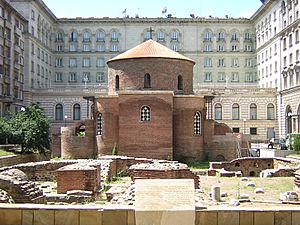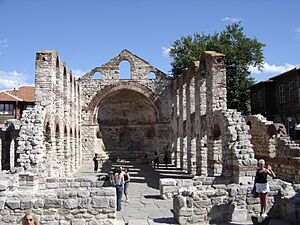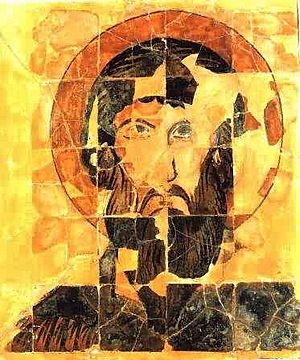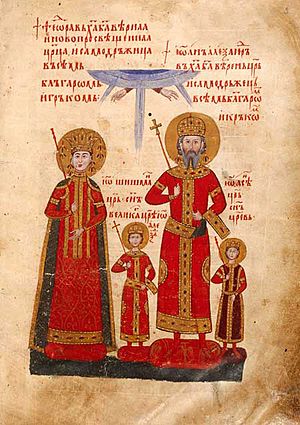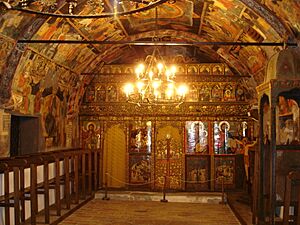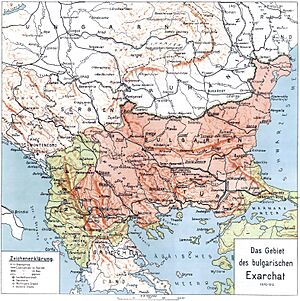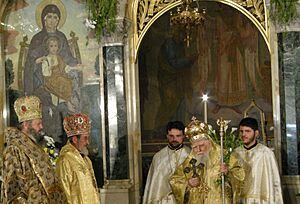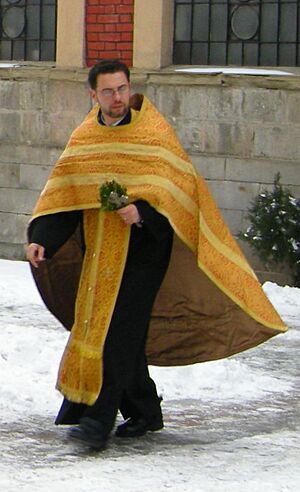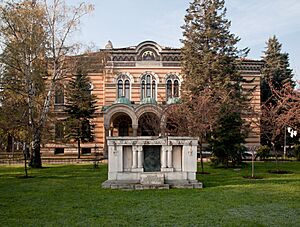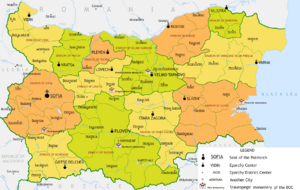Bulgarian Orthodox Church facts for kids
Quick facts for kids Patriarchate of Bulgaria |
|
|---|---|
| Българска патриаршия | |
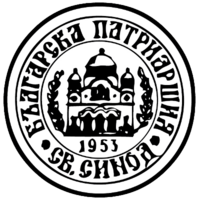 |
|
| Type | Autocephaly |
| Classification | Christian |
| Orientation | Eastern Orthodox |
| Scripture | |
| Theology | Eastern Orthodox theology |
| Primate | Daniil |
| Bishops | 15 |
| Priests | 2,000 |
| Parishes | 2,600 |
| Monasteries | 120 |
| Language | Bulgarian and Old Church Slavonic (Old Bulgarian) |
| Headquarters | Saint Alexander Nevsky Cathedral, Sofia, Bulgaria |
| Territory | Bulgaria |
| Possessions | United States, Canada, Australia, European Union, Argentina, Russia, Greece, Turkey |
| Founder | Boris I of Bulgaria (original) Anthim I (as Bulgarian Exarchate) Stefan I of Bulgaria (modern incarnation) |
| Independence | 870–1018 1185–1393 1018–1767 1870–present |
| Recognition | 870 (Autonomy) 927 (Patriarchate) 1235 (Patriarchate) 1945 (Autocephaly) 1953 (Patriarchate) |
| Separations | Old Calendar Bulgarian Orthodox Church (late 1980s) Bulgarian Orthodox Church – Alternative synod (1996-2013) |
| Members | 7–8 million |
The Bulgarian Orthodox Church (Bulgarian: Българска православна църква, romanized: Bûlgarska pravoslavna cûrkva) is a self-governing Christian church based in Bulgaria. It is also known as the Patriarchate of Bulgaria (Bulgarian: Българска патриаршия, romanized: Bûlgarska patriarshiya). This church was the first Christian church outside the main five ancient centers to be recognized as a Patriarchate in the Middle Ages. It is also the oldest Slavic Orthodox church. Today, it has about 6 million members in Bulgaria and another 1.5 to 2 million members in other parts of Europe, Asia, the Americas, Australia, and New Zealand. The church became fully independent, or "autocephalous," in 1945.
History of the Bulgarian Orthodox Church
Early Christian Beginnings
The Bulgarian Orthodox Church started from strong Christian communities in Southeast Europe. These communities began forming as early as the first centuries AD. Paul and Andrew brought Christianity to the Thracians in the 1st century. By the early 300s, Christianity was the main religion in the area. Important Christian cities included Serdica (Sofia), Philipopolis (Plovdiv), Odessus (Varna), Dorostorum (Silistra), and Adrianople (Edirne).
The Monastery of Saint Athanasius, the first Christian monastery in Europe, was founded in 344 AD. It was built in Thrace near modern-day Chirpan, Bulgaria. Even though there were many raids and attacks in the 4th and 5th centuries, the Christian church in these lands survived. By the mid-800s, most early Slavs in Thrace and Macedonia had become Christians. Some Bulgars also converted. However, the church officially became independent only after Boris I adopted Christianity for the First Bulgarian Empire in 865.
How the Church Was Established
Boris I believed that a strong, independent church would help Bulgaria grow culturally and gain respect. For five years, he worked with both the Patriarch of Constantinople and the Roman Pope. In 870 AD, the Fourth Council of Constantinople finally allowed Bulgarians to have their own independent archbishopric. This church leader was based in Pliska, the Bulgarian capital. His area covered the entire Bulgarian state. The Bulgarian archbishopric was placed under the Patriarch of Constantinople.
At first, the church used the Greek language and had Byzantine priests. This did not help Bulgarian culture or strengthen the Bulgarian Empire. It could have even made Bulgarians lose their identity. Boris I then welcomed the students of Saints Cyril and Methodius in 886. These saints had created the Glagolitic alphabet and a Slavonic church service. This service used the language of the early Slavs from Thessaloniki. In 893, Boris I removed the Greek priests and ordered that the Slav-Bulgarian language be used instead of Greek.
Becoming an Independent Patriarchate
After Bulgaria won two important battles against the Byzantines, the Bulgarian Archbishopric became fully independent. It was also raised to the rank of a Patriarchate at a church meeting in 919. In 927, Bulgaria and the Byzantine Empire signed a peace treaty. The Patriarchate of Constantinople then officially recognized the Bulgarian Orthodox Church as independent and accepted its leader as a Patriarch.
The Bulgarian Patriarchate was the first independent Slavic Orthodox Church. It was established long before the Serbian Orthodox Church (1219) and the Russian Orthodox Church (1596). It was the sixth Patriarchate in the Christian world, after Rome, Constantinople, Alexandria, Antioch, and Jerusalem. The Patriarchate's main seat was in the new Bulgarian capital, Preslav. The Patriarch probably lived in Drastar (Silistra), an old Christian center.
The Ohrid Archbishopric Period
When Bulgaria came under Byzantine rule in 1018, Emperor Basil II (known as the “Bulgar-Slayer”) still recognized the Bulgarian Orthodox Church as independent. He issued special orders that set its boundaries, areas, property, and other rights. However, he took away its Patriarchal title and made it an archbishopric instead. The first archbishop was Bulgarian, but later leaders and higher clergy were Byzantine. Still, most monks and priests remained Bulgarian. The archbishopric kept its national character, used Slavonic church services, and helped Bulgarian literature grow. This independent Ohrid Archbishopric continued to exist until 1767, when the Ottoman Empire abolished it.
The Tarnovo Patriarchate
In 1185/1186, the brothers Peter IV and Ivan Asen I led a successful uprising. This led to the creation of the Second Bulgarian Empire with Tarnovo as its capital. Like Boris I, the brothers wanted an independent church for their independent state. They first set up an independent archbishopric in Tarnovo in 1186. It took almost 50 years for this archbishopric to be recognized as a Patriarchate.
Under Tsar Ivan Asen II (1218–1241), the Bulgarian Orthodox Church ended its connection with Rome. In 1235, a church council was held in Lampsakos. With the agreement of all Eastern Patriarchs, the council confirmed the Bulgarian Orthodox Church's Patriarchal status. It also made the Bulgarian archbishop German a Patriarch.
Even though the area of the Tarnovo Patriarchate became smaller in the late 1200s, it remained very respected in the Eastern Orthodox world. The Patriarch of Tarnovo even confirmed the Patriarchal status of the Serbian Orthodox Church in 1346. The Tarnovo Literary School also developed under the Patriarchate in the 1300s. Important scholars like Patriarch Evtimiy worked there. This period saw a great flourishing of literature, art, and religious writings.
Under Ottoman Rule
Tarnovo fell to the Ottoman Empire in 1393. The Ottomans sent Patriarch Evtimiy into exile, and the church lost its independence the next year. It became part of the Ecumenical Patriarchate. By around 1416, the Tarnovo Patriarchate's territory was fully under the Ecumenical Patriarchate. The other Bulgarian religious center, the Ohrid Archbishopric, survived until 1767.
After many Bulgarian church leaders were executed, the church was fully controlled by the Patriarch of Constantinople. The Ottoman system gave the Patriarch of Constantinople and other church leaders important civil and legal duties. At first, Greek clerics replaced the higher-ranking Bulgarian church leaders. This meant Bulgarians faced pressure from both the Ottomans and the Greek clergy. In the late 1700s, Greek nationalism grew. The Greek clergy tried to make Bulgarians speak Greek and adopt Greek culture. They used the Patriarchate of Constantinople to try and make other peoples become Greek. They opened many schools that taught in Greek and almost banned Bulgarian church services. These actions threatened the survival of Bulgarians as a distinct nation.
During the centuries of Ottoman rule, Orthodox monasteries were very important. They helped preserve the Bulgarian language and national identity. Monasteries like Zograph and Hilandar on Mount Athos, and Rila in Bulgaria, were key. Monks kept their national character, continued Slavonic church services, and preserved Bulgarian literature. They ran monastery schools and other educational activities. This kept Bulgarian culture alive.
The Bulgarian Exarchate
In 1762, St. Paisius of Hilendar, a monk from Bansko, wrote a short history. This was the first work written in modern Bulgarian. It was also the first call for Bulgarians to awaken their national spirit. In History of Slav-Bulgarians, Paissiy urged his people to reject Greek language and culture. Other activists followed his example.
By the 1820s, Bulgarians in several areas were unhappy with the Greek clergy's control. By 1850, Bulgarians actively fought to replace Greek clerics with Bulgarian ones. Most Bulgarian clergy realized they needed some independence from the Patriarchate of Constantinople. The Ottomans saw nationality and religion as the same. Since Bulgarians were Eastern Orthodox, the Ottomans considered them part of the "Roum-Milet," which meant Greeks. To have Bulgarian schools and church services, Bulgarians needed their own church organization.
The struggle between Bulgarians and Greeks grew in the 1860s. By the end of that decade, Bulgarian areas had removed most Greek clerics. This meant that northern Bulgaria and parts of Thrace and Macedonia had effectively separated from the Patriarchate. The Ottoman government restored the Bulgarian Patriarchate under the name "Bulgarian Exarchate" on February 28, 1870. This Exarchate covered present-day northern Bulgaria, Thrace (without the Vilayet of Adrianople), and northeastern Macedonia. In 1874, the Christian people in Skopje and Ohrid voted to join the Exarchate. This gave the Bulgarian Exarchate control over all of Vardar and Pirin Macedonia. The Exarchate also had representatives in southern Macedonia and the Vilayet of Adrianople. So, the Exarchate's borders included all Bulgarian areas in the Ottoman Empire.
The Patriarchate of Constantinople did not like this change. It quickly declared the Bulgarian Exarchate to be in "schism" (a split) and its followers "heretics." The Patriarchate argued that giving up Orthodoxy for ethnic nationalism was wrong.
The first Bulgarian Exarch was Antim I, chosen in February 1872. He was removed by the Ottoman government when the Russo-Turkish War started in 1877. His successor, Joseph I, greatly expanded the church and school network in Bulgaria and other regions. In 1895, the Tarnovo Constitution officially made the Bulgarian Orthodox Church the national religion. Before the Balkan Wars, the Bulgarian Exarchate had many dioceses, parishes, priests, monasteries, and schools in Macedonia and the Adrianople Vilayet.
In 1913, Exarch Joseph I moved his offices from Istanbul to Sofia. He passed away in 1915. After the Treaty of Neuilly-sur-Seine in 1919, the Bulgarian Exarchate lost its areas in Macedonia and Aegean Thrace. For three decades after Joseph's death, the Bulgarian Orthodox Church did not elect a regular head. The Holy Synod governed the Church during this time.
Restoring the Bulgarian Patriarchate
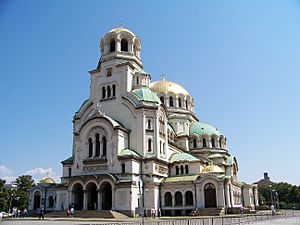
After World War II, the conditions were right to restore the Bulgarian Patriarchate. In 1945, the split with the Patriarch of Constantinople ended, and the Bulgarian Church's independence was recognized. In 1950, the Holy Synod adopted new rules to bring back the Patriarchate. In 1953, Cyril, the Metropolitan of Plovdiv, was elected Bulgarian Patriarch. After Patriarch Cyril's death in 1971, Maxim was elected. He led the church until his death in 2012. On November 10, 2012, Metropolitan Cyril of Varna was chosen as an interim leader to organize the election of a new Patriarch.
At the church council on February 24, 2013, Neophyt, the Metropolitan of Ruse, was elected Patriarch of the Bulgarian Orthodox Church. He received 90 votes.
During the Communist period (1944–1989), Bulgaria's rulers tried to control the church. The early years after the war were difficult for church leaders. From 1944 to 1947, the church lost its power over marriages, divorces, and birth/death certificates. These had been both religious ceremonies and state events. Communists removed religious studies from school. They spread anti-religious messages and punished some priests. From 1947 to 1949, the campaign against the church was at its strongest. Some clergy were killed or accused of crimes against the state. The communists soon replaced any clergy who did not support the government.
From then until the end of Communist rule in 1989, the Bulgarian Orthodox Church and the Bulgarian Communist Party worked together. Many members of the church's Holy Synod worked for the communist State Security. The party supported the church becoming a Patriarchate in 1953. The Bulgarian Orthodox Church did not recognize the independence of the Macedonian Orthodox Church for a long time. However, after the Ecumenical Patriarchate and Serbian Orthodox Church recognized the Macedonian Church in May 2022, the Bulgarian Church followed in June 2022.
Church Structure and Organization
The Bulgarian Orthodox Church sees itself as a part of the one, holy, and apostolic Christian church. It is organized as a self-governing body called a Patriarchate. It has thirteen main areas (called dioceses) within Bulgaria. It also has two more dioceses for Bulgarians living in Western and Central Europe, and in the Americas, Canada, and Australia. These dioceses are divided into 58 church counties, which then have about 2,600 local churches (parishes).
The highest religious, legal, and administrative power for the entire Bulgarian Orthodox Church is held by the Holy Synod. This group includes the Patriarch and the leaders of the dioceses, who are called metropolitans. Local church life in the parishes is guided by about 1,500 parish priests.
Here are the main church areas (Eparchies) in Bulgaria:
- Eparchy of Vidin (Видинска епархия)
- Eparchy of Vratsa (Врачанска епархия)
- Eparchy of Lovech (Ловешка епархия)
- Eparchy of Veliko Tarnovo (Търновска епархия)
- Eparchy of Dorostol (Доростолска епархия) (based in Silistra)
- Eparchy of Varna and Veliki Preslav (Варненскa и Bеликопреславска епархия) (based in Varna)
- Eparchy of Sliven (Сливенска епархия)
- Eparchy of Stara Zagora (Старозагорска епархия)
- Eparchy of Plovdiv (Пловдивска епархия)
- Eparchy of Sofia (Софийска епархия)
- Eparchy of Nevrokop (Неврокопска епархия)
- Eparchy of Pleven (Плевенска епархия)
- Eparchy of Ruse (Русенска епархия)
And the Eparchies outside Bulgaria:
- Eparchy of Central and Western Europe (based in Berlin);
- Eparchy of USA, Canada and Australia (based in New York City)
The Bulgarian Orthodox Church also has about 120 monasteries in Bulgaria. These are homes to around 2,000 monks and nearly as many nuns.
See also
 In Spanish: Iglesia ortodoxa búlgara para niños
In Spanish: Iglesia ortodoxa búlgara para niños
- Eastern Orthodox Church
- Bulgarian Orthodox Church – Alternative synod


